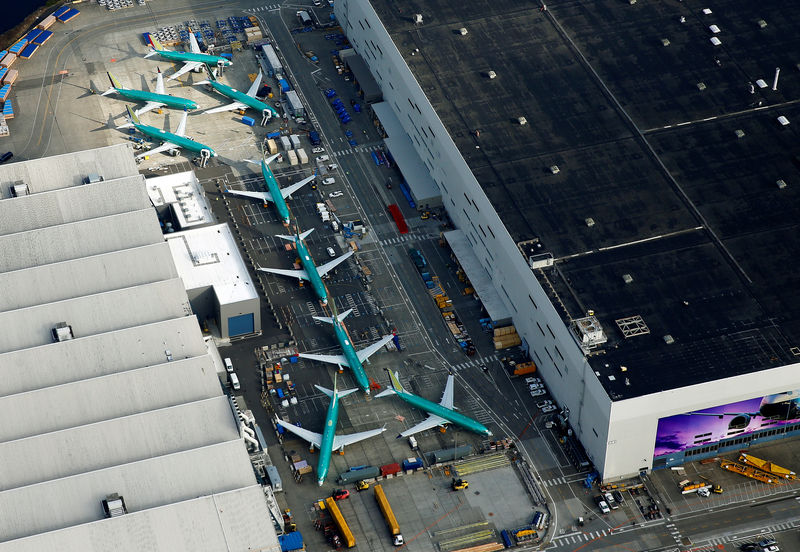By Alwyn Scott and Eric M. Johnson
NEW YORK/SEATTLE (Reuters) - Much like tapping the brake pedal in a car to disengage cruise control, a sharp tug on the controls of older models of Boeing (NYSE:BA) Co's 737 used to shut off an automatic trim system that keeps the plane flying level, giving the pilot control.
But Boeing disabled the "yoke jerk" function when it brought out the 737 MAX, the latest version of its top-selling jet - and many pilots were unaware of the change, aviation experts told Reuters.
(Understanding controls on the Boeing 737 MAX: https://tmsnrt.rs/2OjLSAt)
(Boeing 737 MAX deliveries in question interactive: https://tmsnrt.rs/2Hv2btC)
(Ethiopian Airlines crash and black boxes: https://tmsnrt.rs/2ChBW5M)
The difference may help explain why pilots struggled to keep their aircraft climbing after takeoff on two fatal 737 MAX flights less than five months apart that killed 346 people.
Pilots of a Lion Air flight that crashed in October scoured a handbook for answers as the plane repeatedly lurched downward in the first minutes of flight, Reuters reported.
An Ethiopian Airlines flight that went down on March 10 showed "clear similarities" to the Lion Air accident, aviation authorities said after seeing black-box data.
A pair of switches on the center console between the pilots will turn off the automatic trim and a mechanism, new on the 737 MAX, known as the Maneuver Characteristics Augmentation System, or MCAS, that is suspected of playing a role in both disasters.
TRAINING MATERIAL 'NOT CLEAR'
But pilots would have needed to know that MCAS existed, that it had unusual power to force the plane down and that "a hard pull on the yoke" would no longer turn off the automatic trim that uses MCAS, John Hansman, an aeronautics professor at MIT, said in an interview.
"That wasn't clear to the pilots flying the airplane," Hansman said. "The training material was not clear on that."
Boeing declined to comment. In the aftermath of the Lion Air crash, Boeing pointed to long-established procedures that pilots could have used to handle a malfunction of the anti-stall system, regardless of whether the pilots knew MCAS existed.
That checklist tells pilots to switch off the two stabilizer trim cutout switches on the central console, and then to adjust the aircraft's stabilizers manually using trim wheels.
An American Airlines flight manual mentions MCAS only in a table of acronyms, according to an October 2018 edition of the 1,400-page book seen by Reuters. Pilots have raised questions about why more detail on MCAS was not included.
The American Airlines manual's two-page description of trim controls describes a "trim circuit," but not how MCAS could be triggered by a faulty sensor reading, which is also suspected in the two crashes.
PREVENTING A DANGEROUS STALL
The MCAS system was designed to counteract the effect on the plane's handling caused by new larger 737 MAX engines, which had to be placed farther forward and higher on the wings because the 50-year-old 737 design sits relatively low to the ground. That move gave the MAX a tendency to nose up into a stall, a dangerous position in which a plane loses lift as too little air flows across its wings.
MCAS, essentially a few lines of computer code in the flight control system, relies on data from two small, blade-shaped sensors near the nose of the aircraft that measure the angle of air flow. Faults in the sensors are not uncommon, and MCAS relies on only one sensor at a time during flight. In the Lion Air crash, investigators found a faulty reading led the plane's computer to believe it was stalled and to push the nose down.
Boeing later issued a bulletin reminding pilots how to respond to such a faulty reading. An optional warning light could have alerted pilots to the faulty sensor.
MAINTENANCE, TRAINING UNDER SCRUTINY
Investigators unraveling the Lion Air crash are looking at maintenance records and whether the pilots had enough training to handle the emergency, among other factors.
The 737 MAX can fly without MCAS, so the feature was not considered "flight-critical" even though it has extraordinary power to steer the plane, said an industry expert with knowledge of the system who spoke on condition of anonymity. MCAS controls the large horizontal wing on the plane's tail known as the stabilizer, while the pilot controls smaller flaps or "elevators" on the stabilizer.
Over several minutes, the stabilizer can shift position enough that the elevator controls can no longer counteract the downward direction of the plane, the source said.
"They gave more control power to the automation than to the pilot," the source said of the MCAS design.
The Lion Air pilots flew for about five minutes by using the elevator to counteract the stabilizer every 15 or 20 seconds, said Hansman, based on readings from the flight data recorder. After that, the pilot tried pulling back hard on the controls.
"That's what suggests that the crew didn't understand the system. They thought they were shutting MCAS off and didn't," Hansman said. "Whereas any time during the entire sequence, they could have reached to the middle console and just shut it off."
